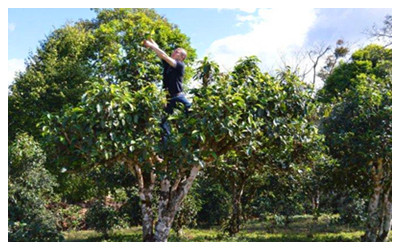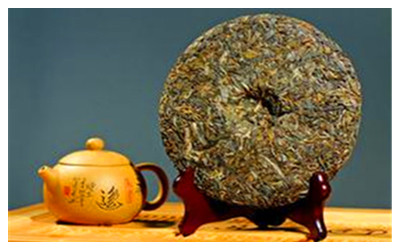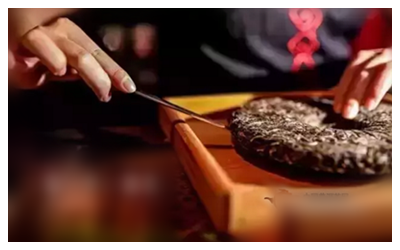
Yunnan Pu'er Tea
Features of Pu'er Tea
 Pu-erh Tea can be divided into cooked and raw types. The cooked types are the varieties that have gone through a process which accelerate post-fermentation, while the raw types are the varieties that have gone through the process of gradually darkening by exposure to the environmental elements instead of fermentation. And this is why the teas are labeled with the region and the year it was produced.
Pu-erh Tea can be divided into cooked and raw types. The cooked types are the varieties that have gone through a process which accelerate post-fermentation, while the raw types are the varieties that have gone through the process of gradually darkening by exposure to the environmental elements instead of fermentation. And this is why the teas are labeled with the region and the year it was produced.The Pu'er tea trees are growing in the subtropical zones in the South China provinces. However, they grow best in the moist valleys between the elevations of 1200-1400 m above sea level, primarily in the forest in the South Yunnan Province of China.
The Pu'er tea trees are an evergreen woody plant growing as trees in arbors or as bushes. They are also called "big leave tea trees" in comparison with smaller leaved trees and bushes.The trees can grow up to 5 to 15 meters tall with a diameter of over 1 meter. The leaves measure 4 – 15 cm. Because of its leaf size. Most of the wild tea trees are very old with hundreds or thousands years history.
How to make Pu'er Tea?
Usually, it has the 6 steps to make Pu'er Tea, which are listed as below:
 Step 01: Withering: high temperature processing of the fresh leaves to get rid of the water inside.
Step 01: Withering: high temperature processing of the fresh leaves to get rid of the water inside.
Step 02: Rolling: softened leaves are rolled into cords;
Step 03: Drying: exposure to the sun light;
Step 04: Grading: manually select the leaves for the different grades of tea;
Step 05: Molding: steam process to soften the tea leaves and use different molds to shape the tea into various shapes (discs, bricks, and etc);
Step 06: Airing; this stops the steaming process and allows the tea to cool.
Another process was introduced in 1973 from a Guangdong oolong tea Company. It is called Piles Fermentation. This process is added between Step 04 and 05. In this process, the steamed tea leaves after grading are put in indoors areas. Yeasts and other moulds are added, sprayed with water and then covered with a tarpaulin to facilitate the oxidation and begin the fermentation of the yeasts. Tea processed this way is referred to as the "Ripe Pu-erh", in contrast to the "Raw Pu-erh" made with traditional technique.
How to brew?
 It is different to brew Pu'er tea from to brew green tea. It has its own brewing method. Here are the general steps and methods for brewing Pu'er tea.
It is different to brew Pu'er tea from to brew green tea. It has its own brewing method. Here are the general steps and methods for brewing Pu'er tea.
1. Insert the tea knife from the side of the tea cake along the edge and push upwards to pry the tea cake apart.
2. Put about 8g of the pried tea leaves into the tea mug for its use.
3. Use boiling water to uniformly warm the pots, including bowls, fair cups, and tasting cups, to raise the temperature of the tea pot, so that the tea leaves are evenly heated.
4. Put the prying tea leaves into the bowl and prepare to fill with water.
5. Brew in boiling water, inject water at a fixed point to release the perfect tea aroma.
6. Pour the tea soup in the bowl into a fair cup. Observe the color of the soup, the translucent tea is good tea.
7. Infuse the golden and translucent tea soup in the fair cup into the tea tasting cup, usually full seven minutes, leaving three points.
8. Serve the guests with Pu'er tea and taste the wonderful taste of Pu'er tea together.
9. The leaf bottom is the "old bottom" of Pu'er tea (whether your Pu'er tea material is good or not, you will know when you look at the leaf bottom). If the texture of the leaf bottom after soaking is clear, and it is like silk cloth, stretched and stretched by hand, the tea is good.







 Ask Questions ?
Ask Questions ?